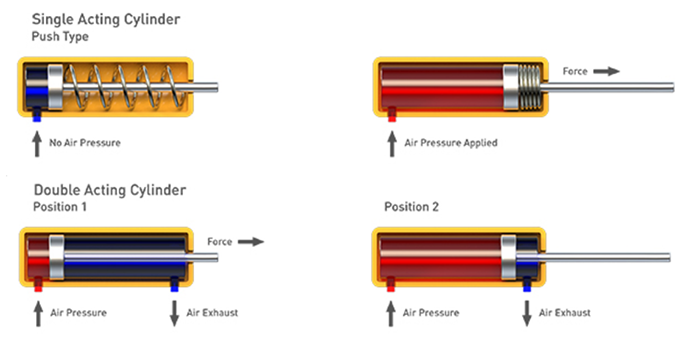Looking for ways to further reduce your compressed air demand? Consider investigating air cylinder actuation.
Often times, air cylinders in production machinery only require significant force during a single power stroke, but still use full line pressure to return the cylinder to resting position. Let’s compare the air consumption for double acting versus a spring return cylinder.

Consider an example double acting air cylinder with an internal swept volume of one cubic foot. To move the cylinder from resting position (at 0 psig) to the end of the stroke and fill it to 100 psi would consume about 6.9 cubic feet of compressed air. To move it back to resting position the compressed air for the power stroke is blown off through an exhaust, and the other side of the cylinder pressurized to 100 psi to return it, consuming another 6.9 cubic feet of compressed air (minus the volume of the rod).
Use of the same volume cylinder with spring return would reduce the compressed air consumption by about 50% because no compressed air would be required for the retract stroke.
Some other ways to reduce cylinder consumption:
- Reduce power stroke pressure – Often, the power stroke will not need 100 psi. Every 14.5 psi reduction reduces one volume of compressed air for the stroke, so using a reduced regulated pressure can save compressed air.
- Use reduced retract pressure – If spring return is not possible, reducing the retract stroke pressure will reduce the compressed air consumption per stroke by one volume for every 14.5 psi. Often very little force is required to retract cylinders.
- Use gravity – Sometimes cylinders lift against gravity, the force of gravity can sometimes be used to provide the force for the retract stroke.

Paul makes a good points about using less air, with a single acting cylinder. You also save a little on the piping. I usually avoid single acting cylinders for the following reasons:
1. The spring adds significant length to the cylinder
2. The extend force is reduced somewhat as the spring compresses.
3. The return force is limited to the internal spring.
Having said that, I agree single acting spring return cylinders do have their place, and should be considered. Good point about using reduced air pressure on return when possible, obviously more important the larger the cylinder.
It is very good idea to use single acting cylinder for various jigs and fixture used for holding or positioning the components. It will save compressed air energy which is eight times costlier than the electrical energy.
Thank you
Single acting cilinders are more expensive,
3 way valves became expensive too because they are servoactuated,
Single acting actuators are less reliable on long strokes ( over 75 mm)
All this made the market to move to double acting actuators but the air comsumption became almost twice of the single acting ones.
One solution to cut air comsumption is provided by SMC wiht Flow regulators with Pressure control included to control pressure (ASR) for on the return stroke and (ASQ) flow control in-out combined quick exhaust valve to exhaust the counterpressure making possible a fast return at reduced pressure.
https://smc-static-resources-prd.s3.eu-central-1.amazonaws.com/products/videos/ASQ_en_EU.mp4
Would a “spring return” type cylinder require higher pressure for forward stroke to overcome the spring pressure than a double acting cylinder?